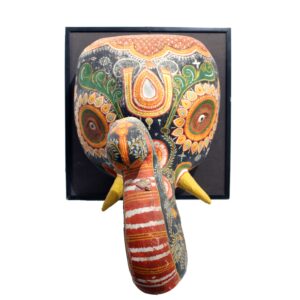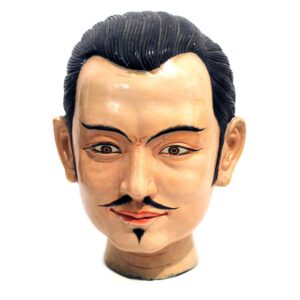Traditional masks of Nepal can be devided into two sorts: “Tribal” masks which belong to the ethnic groups such as Gurung, Magar, Tharu, Rai etc and which are also referred to as “shaman’s” masks; and “classical” masks which represent Hindu and Buddhist gods and goddesses.
The classical Nepali masks always represent deities or demons and never the dead or the ancestors. Besides, masks are more often used in processions and in rituals rather than in theatrical performances.
There are three categories of masks: first, masks representing faces of gods which are worn by performers during ritual dances, a second category, masks which serve as ornamental motifs for decorating a temple, a chariot during a procession or a vase used as a ritual object. A third category includes masks in metal or stone representing faces of deities that are worshiped like statues. They are called statue-masks. The metal used for making them are silver, brass or bronze. These masks are often decorated with jewels and when not worshiped they are kept in a wooden box inside the temple.
The masks which are used in ritual dances are made of such materials as papier mache or wood plastered with clay and linen, and are painted in lively colours. So, such masks are never old as they can’t survive long in such climate. Besides, according to tradition many masks are supposed to be destroyed after use and be re-made the following year. The oldest known Nepali masks date from the 17th century. The deities represented by masks are numerous: Shiva, Bhairava, Ganesh, Kumari, Varahi, Durga, Laxmi, Sima and Duma, these last two are said to be popular names for lion and tiger.
(courtsey: master-craftblogspot)




Bhairav Mask, Nepal
₹16,500.00
Dimension: 10X11 Inches
Medium: Wood
Additional information
| Weight | |
|---|---|
| Dimensions | 10X11 Inches |
| Medium | Wood |
| Provenance | Nepal |




